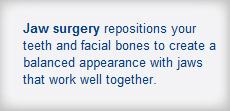Why corrective jaw surgery may be needed
 Injury may prompt the need for corrective jaw surgery, but often people are born with jaws and teeth that don’t meet correctly. This may cause temporomandibular joint pain and dysfunction (TMD) and difficulties with speech and chewing. Orthognathic jaw surgery can reposition your teeth and facial bones to create a balanced appearance with jaws that work well together.
Injury may prompt the need for corrective jaw surgery, but often people are born with jaws and teeth that don’t meet correctly. This may cause temporomandibular joint pain and dysfunction (TMD) and difficulties with speech and chewing. Orthognathic jaw surgery can reposition your teeth and facial bones to create a balanced appearance with jaws that work well together.
What to expect before, during and after surgery
 Your orthodontist and Northwest Oral & Facial Surgery will work with you to develop the right plan tailored to your specific needs. X-rays, photographs and models may be taken to help assess your situation. Whether you have an “open bite,” protruding lower jaw, receding lower jaw or other issue, you may need orthodontic braces to move your teeth into a new position before surgery. Depending on your situation, corrective jaw surgery may be performed under general anesthesia in a hospital, an ambulatory surgical center or at the Northwest Oral & Facial Surgery office.
Your orthodontist and Northwest Oral & Facial Surgery will work with you to develop the right plan tailored to your specific needs. X-rays, photographs and models may be taken to help assess your situation. Whether you have an “open bite,” protruding lower jaw, receding lower jaw or other issue, you may need orthodontic braces to move your teeth into a new position before surgery. Depending on your situation, corrective jaw surgery may be performed under general anesthesia in a hospital, an ambulatory surgical center or at the Northwest Oral & Facial Surgery office.
During surgery, your Northwest Oral & Facial Surgeon will reposition the jawbones according to the plan developed for you. Sometimes bone may be added, reshaped or removed. Incisions are usually made inside the mouth to avoid visible scarring. If small incisions are required outside of the mouth, we take care to minimize their appearance.
After surgery, you’ll receive instructions for a modified diet and a schedule for transitioning back to your regular diet. Post-surgical discomfort can be controlled with medication, and patients typically go back to school or work within one to three weeks. The initial healing phase is about six weeks, and complete healing of the jaws occurs between nine and 12 months. For further information, refer to our pre- and post-surgery instructions.